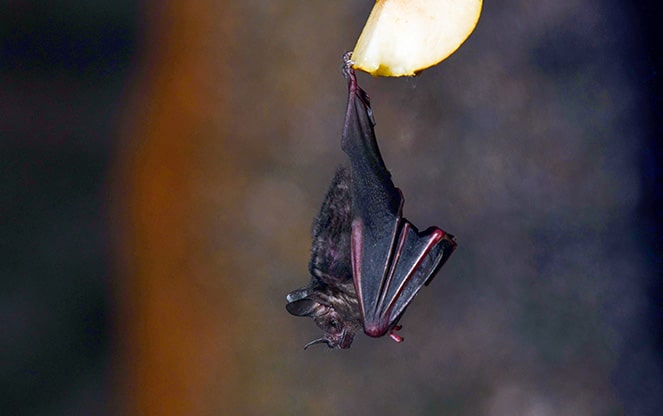Bats are fascinating creatures, often misunderstood, that emerge at dusk to carry out their silent yet vital work in nature. While many people associate them with darkness and tales of fright, these mammals play a fundamental role in maintaining the planet’s health.
In this article, we’ll explore what bats are, the different types, their characteristics and habitats, and how they contribute to keeping ecosystems in balance.
What are bats?
Bats are the only mammals capable of sustained flight. With more than 1,400 species worldwide, they are the second most diverse group of mammals, surpassed only by rodents.
These remarkable animals belong to the order Chiroptera, which in Greek means “hand-wing” – a nod to the structure of their wings, essentially an ingenious adaptation of their forelimbs. In short, their very anatomy shows they were quite literally born to fly.
Types of bats: two major families
Bats are divided into 2 major families:
- Megabats: often called flying foxes, these bats tend to be larger and primarily feed on fruits and nectar. They can locate food because of their excellent vision and keen sense of smell. Tropical regions like Africa, Asia and Oceania are home to the majority of megabats.
- Microbats: generally smaller, microbats rely on echolocation (a sound-based navigation system like radar) to move and hunt in the dark. Most microbats feed on insects, although some species also consume fruit, nectar, or even blood, as is the case with vampire bats.
Up to seven distinct bat species can be found in the Canary Islands including the mountain bats the clear-edged bat which is frequently observed in Lanzarote and Fuerteventura and the Canary long-eared bat which lives in Tenerife, and La Gomera.
Characteristics of bats
Bats have a range of unique adaptations that set them apart. One of their most remarkable traits is their ability to use echolocation, particularly in microbats. They emit sounds that bounce off objects around them, and by interpreting the returning echoes, they can determine the distance, size, and shape of objects, allowing them to see even in complete darkness.
In addition, bats have a fast metabolism, enabling them to digest food within just a few hours. This rapid digestion is crucial for maintaining the energy they need for sustained flight.
Habitat: homes in the most unexpected places
Bats adapt to a wide variety of habitats. They can be found in jungles, forests, caves, abandoned mines and, quite often, in cities. During the day, they seek shelter in dark, quiet places such as caves, rock crevices, hollow trees or buildings. These roosts not only provide protection against predators but also serve as essential sites for resting and breeding.
Diet: what do bats eat?
The diet of bats is highly varied and largely depends on the species. The main dietary groups include:
- Insectivores– insect-eating bats are natural allies of farmers, as they consume large numbers of insects, including agricultural pests. They are therefore vital for pest control.
- Frugivores– this is the type of bat you can see at Loro Parque. They feed on fruit, insects and pollen, and play a crucial role in seed dispersal, helping to regenerate forests.
- Nectarivores– these bats feed on nectar and pollen, making them essential pollinators for many plants, including some that rely solely on bats.
- Carnivores and haematophages– a few species hunt fish, frogs and small animals, while vampire bats feed on small amounts of blood from other animals. This unusual diet is extremely rare, accounting for just 3 out of the 1,400 described species.
The true role of bats in the ecosystem
Bats play an indispensable role in maintaining ecological balance.
- Pest control– insectivorous bats consume tonnes of insects every night, including mosquitoes and agricultural pests. This not only reduces the need for pesticides but also helps farmers protect their crops.
- Pollination and seed dispersal– nectar-feeding and fruit-eating bats are essential for the pollination of many plants, such as agaves and a variety of tropical trees. In turn, this allows plants to reproduce and contributes to the regeneration of forests.
- Nutrient recycling– bat droppings, known as guano, are a highly valuable natural fertiliser for the soil. This contribution enhances soil fertility and encourages healthy vegetation growth.
Bat conservation: protecting the guardians of the night
Although bats are essential to the environment, many species are under threat due to habitat destruction, the use of pesticides, diseases such as white-nose syndrome (a fungus that has devastated bat populations in North America), and human persecution driven by fear and misinformation.
According to the IUCN, almost 20% of the world’s bat species are currently considered threatened to some degree.
It is therefore vital to promote the conservation of these animals. Some of the most effective ways to help include:
- Protecting natural habitats– avoiding deforestation and the destruction of caves where bats roost.
- Reducing pesticide use– these chemicals not only harm insects but can also indirectly affect the bats that consume them.
- Raising awareness and educating others– dispelling negative myths about bats is crucial to encouraging respect and protection across all ages.
By taking these steps, we can ensure that bats continue their vital role in maintaining healthy ecosystems and supporting the planet.
The importance of preserving the night flyers
As true night watchmen, bats are vital to the health of ecosystems and the preservation of natural equilibrium. These tiny mammals play an essential role in pollinating plants, regenerating forests, and controlling pests—all of which benefit the environment and people.
The ecological services provided by bats are irreplaceable. Their nightly insect consumption prevents outbreaks of harmful pests, which would otherwise devastate crops and spread diseases such as malaria and dengue fever. By reducing the need for chemical pesticides, bats support sustainable agricultural practices and promote healthier ecosystems.
Bats play a crucial role in pollinating a wide range of plants, including culturally and economically important species such as agave, essential for tequila production, and cacao, the source of chocolate. Moreover, they contribute to the spread of seeds, promoting the growth of numerous tropical plants. This process helps restore forests, supports biodiversity, and safeguards wildlife habitats. Additionally, by fostering forest regeneration, bats contribute to climate change mitigation through enhanced carbon storage in these ecosystems.
Beyond their ecological importance, bats provide insights into scientific advancements. Their unique biological traits have inspired innovations in medicine, such as anticoagulants derived from their saliva, and in technology, with echolocation influencing advancements in sonar and robotics.
How Loro Parque contributes to bat conservation
Bats are true guardians of the night, playing an essential role in maintaining the natural balance and health of ecosystem. From controlling pests to pollinating plants and regenerating forests, these small mammals perform vital functions that benefit both the environment and humanity.
Learning more about them and recognising their importance is a crucial step towards ensuring their conservation and protecting biodiversity.
Although they represent around 20% of all mammal species on the planet, the true characteristics of bats remain little known. Often associated with the image of vampires, they are mistakenly perceived as dangerous, when in fact they are essential to the stability of ecosystems.
At Loro Parque, we are committed to promoting awareness, education, and understanding about animal species — dispelling myths and sharing accurate, science-based information.
Frequently asked questions about bats
Are bats rodents?
No, bats are not rodents. They belong to their own order, Chiroptera, which makes them unique among mammals. In fact, they are more closely related to primates than to rodents.
Are bats dangerous?
For the most part, bats are harmless to humans. The vast majority feed on insects, fruit or nectar, and only a very small number of species (such as vampire bats) feed on blood. Even then, they rarely pose a real threat to people.
Baby bats
They are called pups. They are usually born in the summer and depend on their mothers’ milk until they are old enough to fly and feed themselves. In some species, mothers gather in maternity colonies, where they raise their pups together.
Visit us and discover just how spectacular the animal kingdom is – and how much we can learn from it!












